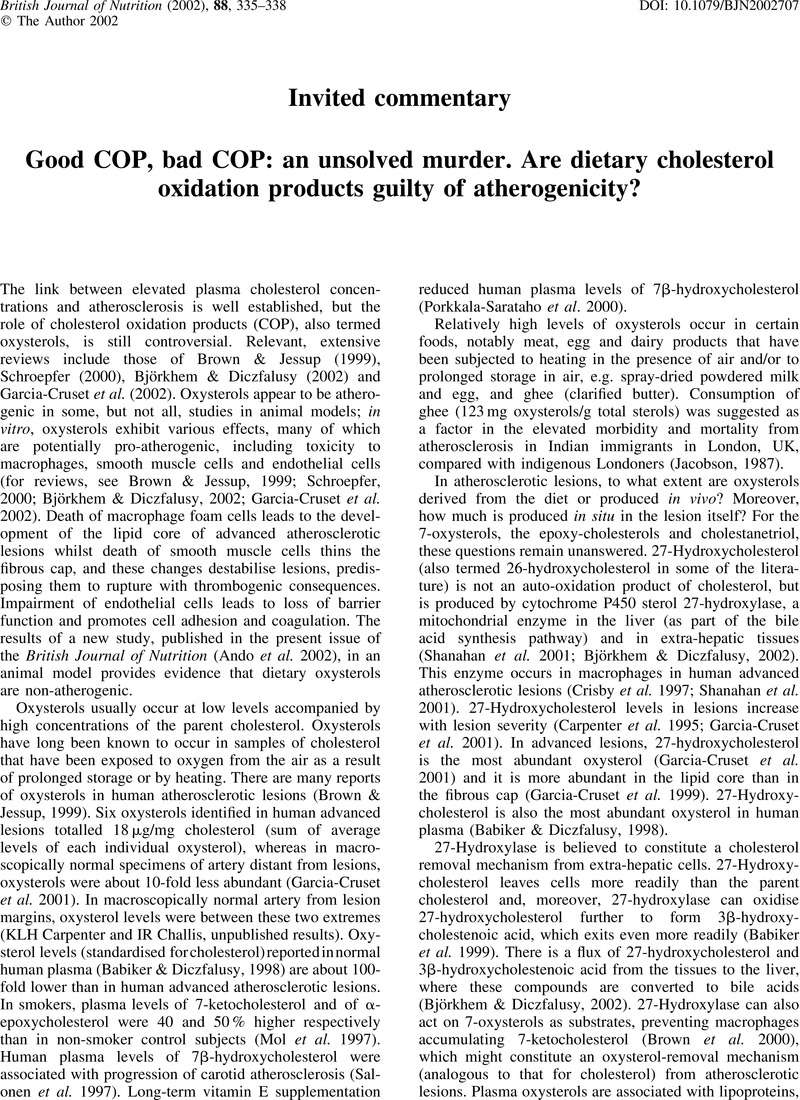Crossref Citations
This article has been cited by the following publications. This list is generated based on data provided by Crossref.
Carpenter, Keri L.H
Challis, Iain R
and
Arends, Mark J
2003.
Mildly oxidised LDL induces more macrophage death than moderately oxidised LDL: roles of peroxidation, lipoprotein‐associated phospholipase A2 and PPARγ.
FEBS Letters,
Vol. 553,
Issue. 1-2,
p.
145.
Calder, Philip C.
and
Deckelbaum, Richard J.
2003.
Fat as a physiological regulator: the news gets better.
Current Opinion in Clinical Nutrition and Metabolic Care,
Vol. 6,
Issue. 2,
p.
127.
Tomoyori, Hiroko
Kawata, Yayoi
Higuchi, Tomoko
Ichi, Ikuyo
Sato, Hiroyoshi
Sato, Masao
Ikeda, Ikuo
and
Imaizumi, Katsumi
2004.
Phytosterol Oxidation Products Are Absorbed in the Intestinal Lymphatics in Rats but Do Not Accelerate Atherosclerosis in Apolipoprotein E–Deficient Mice.
The Journal of Nutrition,
Vol. 134,
Issue. 7,
p.
1690.
Sieber, Robert
2005.
Oxidised cholesterol in milk and dairy products.
International Dairy Journal,
Vol. 15,
Issue. 3,
p.
191.
Lizard, Gérard
2006.
Oxysterol mixtures, a promising approach to investigate the biological effects of oxysterols: A commentary on “Oxysterol mixtures, in atheroma-relevant proportions, display synergistic and proapoptotic effects,” by Larsson, Baird, Diinga Nyhalah, Yuan, and Li.
Free Radical Biology and Medicine,
Vol. 41,
Issue. 6,
p.
872.
Prunet, C.
Petit, J.M.
Ecarnot-Laubriet, A.
Athias, A.
Miguet-Alfonsi, C.
Rohmer, J.F.
Steinmetz, E.
Néel, D.
Gambert, P.
and
Lizard, G.
2006.
High circulating levels of 7β- and 7α-hydroxycholesterol and presence of apoptotic and oxidative markers in arterial lesions of normocholesterolemic atherosclerotic patients undergoing endarterectomy.
Pathologie Biologie,
Vol. 54,
Issue. 1,
p.
22.
Vejux, Anne
Kahn, Edmond
Ménétrier, Franck
Montange, Thomas
Lherminier, Jeannine
Riedinger, Jean-Marc
and
Lizard, Gérard
2007.
Cytotoxic oxysterols induce caspase-independent myelin figure formation and caspase-dependent polar lipid accumulation.
Histochemistry and Cell Biology,
Vol. 127,
Issue. 6,
p.
609.
Hovenkamp, Egbert
Demonty, Isabelle
Plat, Jogchum
Lütjohann, Dieter
Mensink, Ronald P.
and
Trautwein, Elke A.
2008.
Biological effects of oxidized phytosterols: A review of the current knowledge.
Progress in Lipid Research,
Vol. 47,
Issue. 1,
p.
37.
Hartwig, Carmony L.
Rosenthal, Andrew S.
D’Angelo, John
Griffin, Carol E.
Posner, Gary H.
and
Cooper, Roland A.
2009.
Accumulation of artemisinin trioxane derivatives within neutral lipids of Plasmodium falciparum malaria parasites is endoperoxide-dependent.
Biochemical Pharmacology,
Vol. 77,
Issue. 3,
p.
322.
Soto‐Rodríguez, Ida
Campillo‐Velázquez, Perla J.
Alexander‐Aguilera, Alfonso
Rodríguez‐Estrada, María Teresa
Lercker, Giovanni
and
Garcia, Hugo S.
2009.
Biochemical and histopathological effects of dietary oxidized cholesterol in rats.
Journal of Applied Toxicology,
Vol. 29,
Issue. 8,
p.
715.
Husche, Constanze
Weingärtner, Oliver
Pettersson, Hanna
Vanmierlo, Tim
Böhm, Michael
Laufs, Ulrich
and
Lütjohann, Dieter
2011.
Validation of an isotope dilution gas chromatography–mass spectrometry method for analysis of 7-oxygenated campesterol and sitosterol in human serum.
Chemistry and Physics of Lipids,
Vol. 164,
Issue. 6,
p.
425.
Tian, Ling
Wang, Hua
Abdallah, Ahmed Moursy
Prinyawiwatkul, Witoon
and
Xu, Zhimin
2011.
Red and White Wines Inhibit Cholesterol Oxidation Induced by Free Radicals.
Journal of Agricultural and Food Chemistry,
Vol. 59,
Issue. 12,
p.
6453.
Vicente, Silvio J. V.
Sampaio, Geni R.
Ferrari, Carlos K. B.
and
Torres, Elizabeth A. F. S.
2012.
Oxidation of Cholesterol in Foods and Its Importance for Human Health.
Food Reviews International,
Vol. 28,
Issue. 1,
p.
47.
Sato, Kei
Nakano, Kaku
Katsuki, Shunsuke
Matoba, Tetsuya
Osada, Kyoichi
Sawamura, Tatsuya
Sunagawa, Kenji
and
Egashira, Kensuke
2012.
Dietary Cholesterol Oxidation Products Accelerate Plaque Destabilization and Rupture Associated with Monocyte Infiltration/Activation via the MCP-1-CCR2 Pathway in Mouse Brachiocephalic Arteries: Therapeutic Effects of Ezetimibe.
Journal of Atherosclerosis and Thrombosis,
Vol. 19,
Issue. 11,
p.
986.
Kulig, Waldemar
Cwiklik, Lukasz
Jurkiewicz, Piotr
Rog, Tomasz
and
Vattulainen, Ilpo
2016.
Cholesterol oxidation products and their biological importance.
Chemistry and Physics of Lipids,
Vol. 199,
Issue. ,
p.
144.
Serra, Gessica
Deiana, Monica
Spencer, Jeremy P. E.
and
Corona, Giulia
2017.
Olive Oil Phenolics Prevent Oxysterol‐Induced Proinflammatory Cytokine Secretion and Reactive Oxygen Species Production in Human Peripheral Blood Mononuclear Cells, Through Modulation of p38 and JNK Pathways.
Molecular Nutrition & Food Research,
Vol. 61,
Issue. 12,
Marwarha, Gurdeep
Raza, Shaneabbas
Hammer, Kimberly
and
Ghribi, Othman
2017.
27-hydroxycholesterol: A novel player in molecular carcinogenesis of breast and prostate cancer.
Chemistry and Physics of Lipids,
Vol. 207,
Issue. ,
p.
108.
Arnhold, Jürgen
2020.
Cell and Tissue Destruction.
p.
55.



